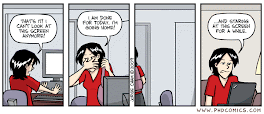This third refractive disorder is the most common of them all, although the most known is myopia. This can coexist with myopia as well as hyperopia (13 percent of population has only got astigmatism, and 20 percent has astigmatism associated with myopia or hyperopia).
Astigmatic person’s vision
 The typical complaints in astigmatism are “`BLURRED VISION´ MAINLY WHEN TRYING TO VIEW DISTANT OBJECTS, AND FREQUENT FRONT HEADACHE”. Only when the astigmatism is high, the complaint is also, “`BLURRED VISION´ AT CLOSE TASKS”.
The typical complaints in astigmatism are “`BLURRED VISION´ MAINLY WHEN TRYING TO VIEW DISTANT OBJECTS, AND FREQUENT FRONT HEADACHE”. Only when the astigmatism is high, the complaint is also, “`BLURRED VISION´ AT CLOSE TASKS”.If you realize I write 'BLURRED VISION' in quotation marks, because this refractive error, usually congenital, causes the outlines of the letters or the objects to be seen distorted; as if there would be some shadows behind every letter or every object, or as if they were seen double or distorted. Actually it is not a BLURRED VISION.
For low and medium quantities of refraction:
- An uncorrected myopic person has low Visual Acuity at distance but it is good at near.
- An uncorrected hyperopic person can have a good Visual Acuity at any distance as long as she has enough accommodation.
- But, in spite of that a little astigmatism of about 0.50 diopter can not appreciably interfere in Visual Acuity in general, a person with uncorrected astigmatism does not have any distance where the image shaped in her retina is perfectly clear. In the case of a hyperopic astigmatism, by using help of the accommodation, it will be easier for itself to achieve better sharpness than a myopic astigmatism.
I am going to show you two simple ways for checking if you or your child has got astigmatism or not:

- Put this image in the computer screen and get yourself away about 1 meter or 1 meter and a half, and covering one eye (and without wearing your glasses, if you have it), check if you can see ALL lines with the same contrast, that is, all of them have the same degree of “blackness” or all of them are clear or all of them are blurred.
If you do not have any astigmatism, the answer will be “yes”; you see it as it is in the drawing, or maybe all drawing is blurred (if you have some myopia or hyperopia).
But if you have it, the answer will be that you see something like this:
(Unless myopia or hyperopia, when we give the value of the astigmatism in a prescription, we give the power of the lens and also the axis of said lens).
This is the most common answer. It would belong to pure astigmatism between 180º and 150º (the astigmatic axis is perpendicular to the lines that you see better). If you have some myopia or hyperopia, as well the rest of axises will be seen out of focus.
- Another clear way to check it is looking at the full moon. If you have some astigmatism, it will be impossible to perceive its outlines and it will be seen elongated and out of focus.

RELATED POST
Refractive disorders: Astigmatism. (2) Appearance
Refractive disorders: Astigmatism. (3) Different features
Refractive disorders: Astigmtaism. (4) Symptoms
Refractive disorders: Astigmatism. (5) Solutions
Refractive visual disorders. Some clarifications.
Some numbers...






2 comments:
Contact lenses are available for people with astigmatism. There is considerable time and skill involved in fitting patients with these lenses but it can be done for all astigmatisms if the patient is highly motivated to try.
Thank you for useful info. :-)
Post a Comment